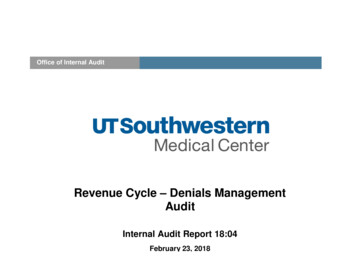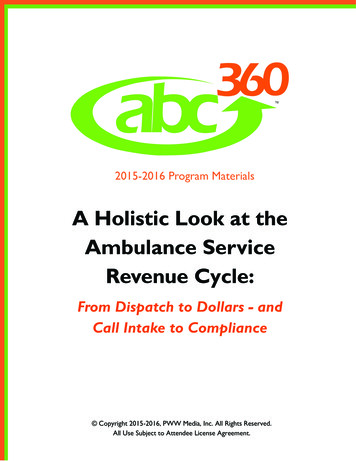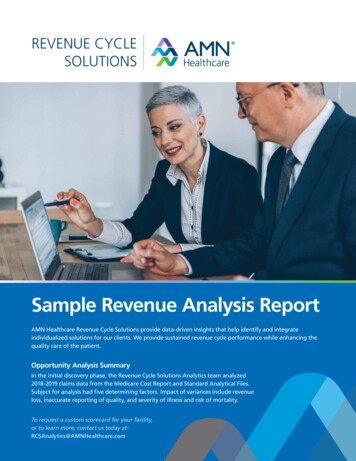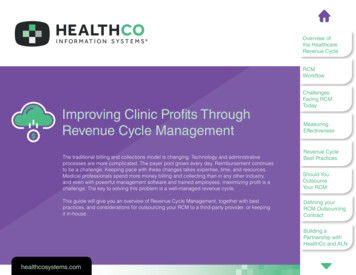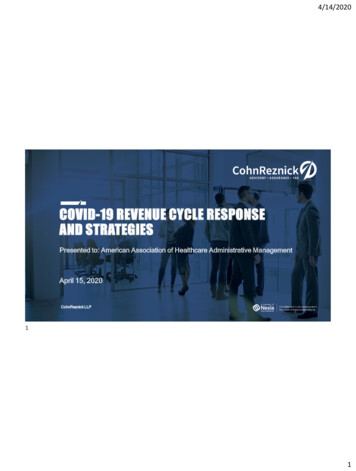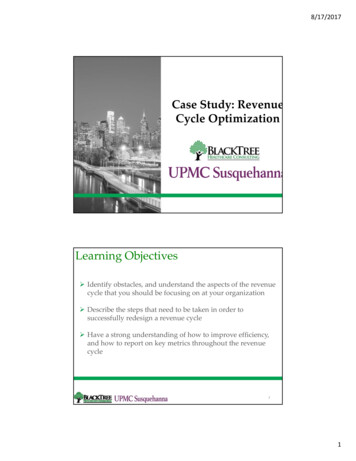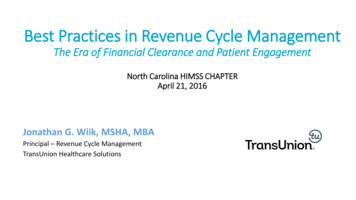
Transcription
Best Practices in Revenue Cycle ManagementThe Era of Financial Clearance and Patient EngagementNorth Carolina HIMSS CHAPTERApril 21, 2016Jonathan G. Wiik, MSHA, MBAPrincipal – Revenue Cycle ManagementTransUnion Healthcare Solutions
Today’s agenda:Revenue Cycle 101: High Level Review Internal DriversBest Practices: Strategies Workflows HIMSS RCTIF G7So What? Industry Trends Market ChallengesPatient Experience: Consumerism Medical Debt Collections Behaviors
Revenue Cycle 101
High Level Revenue CycleFRONT END Referrals / Orders Scheduling Financial Clearance Charity/Public Assistance Registration POS collectionsMID CYCLE Charge capture Documentation/HIM/Coding Medical Necessity Transitions of care/Case ManagementBACK END Claim creation, scrub, submission Insurance Collections/Cash Self-Pay Collections/Early out Payment Posting Denials and Appeal managementSchedulingand IntakeDenials andAppeals /Cash PostingFinancialClearanceRegistrationPOS ns,early outClaim dingMED NEC
The Revenue Cycle“FLOW CELLS”8
Needs . Revenue Expenses Income statement Cash flow Patient experience Employee satisfaction
Why?!BadDebtCharityPaymentCOLLECTIONS
So What?Industry trends and challenges
Key Market Drivers Impacting Financial ClearanceKey n 501r goes into effect Jan 1 ‘16 Allows presumptive eligibility Bars use of Extraordinary Collection Actions(EAC) Greater provider demand for 3rd party data sources & methods for Financial Aidscreening Decreased need for patient attestation/interview, but increased need fordocumentation/demonstration Increased need for batch Financial Aid screening before sending patients to baddebt or collections Greater provider need for Propensity to Pay information for effective Point ofService collections Increasing need for providers to offer multiple and increasingly complex paymentoptions for patients Greater need for Financial Aid and Propensity to Pay during scheduling ®istration2Higher Balance AfterInsurance Amounts High-deductible plans increasing consumer BAI Provider liability shifting from uninsured tounderinsured3Financial ClearanceMoving to Pre-Service Move to financial assistance screening beforeservice Point of Service screening before service45IncreasingHIS IntegrationMedical Debt ReportingRuleImplications for Financial Clearance Providers favoring integration over multiplevendors Providers looking to leverage existing HISworkflow New rule delays & removes consumer medicaldebt from credit report Increasing interest in HIS interface options with major HIS vendors such as EPIC &Cerner Less desire for “bolt-on” applications Decreased reliance on credit data to provide insight into consumers’ ability to paymedical debts Increasing dependence on hospital encounter/ payment history & other non-creditinformation
Source: Kaiser/HRET survey of Employer Sponsored Health Benefits, 1999 -2105; KPMG Survey of Employer-SponsoredHealth Benefits, 1993, 1996; The Health Insurance Association of America HIAI, (1998)
DeductiblesExpendituresCosts/Premiums
Deductibles morethan doubled inlast 10 yearsAverage deductible2003 5182013 1,2732% vs 5% medianincomePercent of workerswith deductibles:2003 52%2013 81%
Annual U.S. Healthcare Expenses per Person by YearAverageHouseholdspends 13Kannually outof-pocket onhealth care
Projected % of U.S. dollar spent by consumer 2015
Premiums for employer and employee growing Annual Contributions to Premium forEmployee and Company 1999-2013 25,000Premiums for employerand employee almosttripled in 10 years 20,000 16,351 15,000 10,000 11,786 5,790 5,000 4,247 4,565 0 1,54319992013Kaiser/HRET Survey of Employer-Sponsored Health Benefits, 1999–2013.
Deductibles – the gift that keeps on givin’ Source: State Trends inthe Cost of EmployerHealthInsurance Coverage,2003–2013THECOMMONWEALTHFUNDJanuary 2015
Steady increase in wage outpaced by out-ofpocket health insurance costs In the last 10 years: 108% increase indeductibles 72% increase inpremiums 23% increase inworker wages
ACA exchange plan deductibles are creating morefunding gaps for patients Bronze plans have a 5400deductible Silver is at 3500 Gold and Platinum are at 1400 and 400 respectively
Underinsured, defined . Out-of-pocket costs, excluding premiums, over the prior 12months are equal to 10 percent or more of householdincome; or Out-of-pocket costs, excluding premiums, are equal to 5percent or more of household income if income is under 200percent of the federal poverty level; or Deductible is 5 percent or more of household income.Commonwealth Fund – The problem of underinsurance and how rising deductibles make it worse
Medical debt – contributing factors“Cost sharing levels under many healthplans now exceed the resourcesthat most families have onhand the Federal Reserve foundthat only 48 percent of Americanswould be able to completely cover ahypothetical emergency expensecosting 400 without sellingsomething or borrowing money.”Medical Debt Among Insured Consumers: The Role of Cost Sharing, Transparency, and Consumer AssistanceJan 08, 2015 Karen Pollitz
Shift in Payment: Consumers now pay more for coststhan their employer Consumers shoulder a greater upfront cost burden Providers must collect paymentdirectly from the consumer, not theinsurerSOURCE: JPM Key trends in healthcare patient payments
Cash decelerationDelays in health care payments areincreasing: Increase in patient portion Regulatory changes Transition from Paper toElectronic workflowsSOURCE: JPM Key trends in healthcare patient payments
Hospitals have increased Financial risk As more consumers are insured and their self-pay responsibility increases,healthcare providers need to update their collections approach tomaking sure revenue is coming in. Accounts receivable (A/R) from insured self-pay patients increased 13percent in the past year. Total A/R over the same time period from uninsured self-pay patientsdecreased 22 percent, mostly as a result of high financial risk patientsjoining Medicaid in expansion states. For every one uninsured self-pay patient payment dollar in the firstquarter this year, there were approximately 22 insured self-pay patientpayment dollars.Source: ACA ncial-risk-36795.aspx
Provider Challenges Increased regulatory, security, reimbursement challenges In healthcare, it is ALL about the patient .but the patient isconfused: What is my coverage? What does this cost? How much am I going to pay? I can’t afford this?! – what do I do now Optimize 3rd party technology where possible Providers LOVE innovation, but FEAR disruption
Revenue Cycle Disruption 1. Competing high-priority projects Maximize/sustain reimbursement through healthcare reformand disruption in the market Teams juggle several major initiatives at once ICD10, MU II, CDI, PRE REG/EMR2. Lack of skilled resources in several areas High turnover Silo’d functional areasSOURCE: Becker’s
Revenue Cycle Disruption 3. Narrowing margins and escalating costs Medicare, Medicaid and commercial reimbursements SMALLER(little/no incremental revenue) Bend the cost curve - increase efficiencies and automate4. Significant market changes PPACA, 501(r), False Claims, Documentation Underinsured/Uninsured5. Fragmented revenue cycle processes Viewed as a “cost” center Disparate systems Denials ManagementSOURCE: Becker’s
Industry Best PracticesApproach and Innovation
Checklists/Gates: Insured /Self Pay 270/271 EMR 3rd party Benefits Auth /Referral /Notification Med necEligibilityProceed / documentStop / escalate MatrixEstimatorP2PFPLVerification Preservice POS PaymentPlans Loans/CreditEstimationCollection
Industry Challenges .ACA DisruptionHDHPs - Patientsare a payer too,versus just theinsurancecompanyPoor PatientEducation andFinancialExperienceUncompensatedCare – Bad debt,Collections,CharityPoor patient experience, uncompensated care
Matched with Best In Class SolutionsInsuranceEligibility ialAssistance,Propensity toPayIncreasedCash flowandPresumptiveCharityFunding established, engaged patients, positive cash flow
A shift in approach to billing . Post-service collections to front-end financial clearance Exception-based work queues from denials management Determine ability to pay and ideally pre-fund high balanceestimates (i.e. Deductibles) or obtain deposits from self-paypatients Engage patient in advance of care to have a financialdiscussion in addition to the clinical discussionSOURCE: JPM Key trends in healthcare patient payments
Providers must adapt their billing and collectionsstrategies to prevent a potential increase in baddebt from impacting profits Financially clear patients early in the process Have documentation for the next person in line Upfront collections critical to capture whole or partial payments Patient payment discussions should occur throughout thetreatment process Medical bill financing services, either directly or throughpartnerships, are an option to allow patients to pay over time Charity care plans will need to incorporate underinsuredpatientsSOURCE: Revenue360, ebt-2/
Top 5 Strategies to Reduce Bad Debt inHealthcare1. Early identification of patients that are high riskfor bad debt2. Request payment prior to services3. Effective training of patient access staff4. Provide reasonable financing options5. Provide uninsured patients discountsSOURCE: Revenue360, ebt-2/
Financial Clearance StrategiesFunding mechanisms and financial clearance EARLY in the process: Scheduling, Pre-registration, Registration Insurance Verification Specialists (IVS) – Auths, Med Nec, Estimates, Charity Automated Insurance Estimates Deposit Schedules/Standard Work Self pay rates – Opt out of Insurance (HIPAA Hi-Tech) Financial Counseling (at Registration – incorporated into hospital design) Charity Program Enhancements - Website, Signage, Forms, Policies –FINANCIAL ASSISTANCE AND DEBT COLLECTION POLICIES
Why are pre-service estimates a good idea?Becker’s: “It’s more important than ever for hospitals to maintaina steady stream of income ” “In an era of high-deductible plans, price estimation canbe a critical pre-cursor to patient collections ” “As more time passes after care is delivered, a patient'spropensity to pay decreases substantially ”Beckers: 10 thoughts on improving hospital collections. Murphy, Brooke. January 6, 2016
Why should patients be asked to pay in advance? You do not get what you do not ask for Patients are 65% more likely to pay when asked PRIORto service (vs after) Bad debt and/or patient bankruptcy avoidance Ensure accuracy for other things (insurance,authorization, etc.)MAHAP/MPAA Revenue Cycle Conference, “ Revenue Cycle Management During the Healthcare Reform Revolution”
Types of Financial Liability
HIMSSRevenue Cycle Improvement Task Force (RCITF) Brings clarity to an emerging dynamic in healthcare Recognized the importance of the patient experience Looked at the impact of patient financial satisfaction ona healthcare provider’s bottom line Patient satisfaction is playing an increasingly moreimportant role Charged to improve the patient payment experienceand reduce physicians’ and other providers’ bad debt.SOURCE: HIMSS Revenue Cycle Improvement Task Force June 2014 “Improving the Healthcare Patient Payment Experience”
HIMSS G7A thought-leader stakeholder group of healthcare providers, health plans,banks, information technology firms, government, employers and consumers,to help envision the healthcare financial network of the futureOpportunities in current state (WHATs): Greater integration between verification of insurance and benefit eligibility; Enhanced collection of more complete patient demographics; Improved mechanisms around capturing charges, coding, and claimssubmissions; Developing processes for collecting payments from an ever-changing patientfinancial means mix; Better denial management; reporting; and data analysis.SOURCE: HIMSS Revenue Cycle Improvement Task Force June 2014 “Improving the Healthcare Patient Payment Experience”
HIMSS G7A thought-leader stakeholder group of healthcare providers, health plans, banks,information technology firms, government, employers and consumers, to help envision thehealthcare financial network of the futureHighlights of Recommendations (HOWs): Get a team together – “Create an internal task force comprised of team members from acrossthe organization’s revenue cycle. Include any group with financial connections to the patient .” Check yourself (claims) – “Review the integrity of the organization’s internal process forsubmitting and adjudicating insurance claims” Take Inventory –“Review your organization’s revenue cycle tools and infrastructure to give theorganization integrated end-to-end solutions and deliver greater patient experiences across theenterprise” Beg, Borrow and Steal – “Become familiar with the HFMA patient friendly billing project”SOURCE: HIMSS Revenue Cycle Improvement Task Force June 2014 “Improving the Healthcare Patient Payment Experience”
Innovations Often, providers also are calculating a propensity topay score whether the patient is insured or not High pre-service patient balances (i.e. deductibles) orself-pay patients are key areas to focus Transactions like credit score, mortgage balanceinquiry, address verification, and more can help: Determine a patient’s propensity to pay Give insight into payment options Determine if a patient is a candidate for payment plans or charity careSOURCE: JPM Key trends in healthcare patient payments
Workflow development Develop POLICY to support the PROCEDURE within theSCOPE of the project Determine: When (Specific Steps – Shift Back to Front) Who (Right Person, Right Job, Right Time) Why (“Funding Mechanism”) What (Elements of Payment) How (Standard Work/Scripting/Key Phrases)
FinancialClearanceWorkflow
HighBalancePatientAccountWorkflow
Deployment Considerations What’s the problem? Denials, cash, debt, cost to collect, patient satisfaction? What is an indicator of performance? Can we measure that? Work the problem (think NASA) Is the number better, worse, or same? Can we fix it? Get a baseline, make a goal, assess gaps, make a plan, and execute PDCA
Deployment Considerations Cannot manage what you do not measure In God we trust, all others bring data Saying and doing are two different things On or Off / No “Dimmers” Do or do not, there is no try
Deployment ConsiderationsAs an example LEAN Denials reduction task force on top 20 reasons a claim denied (PFMEA) POS Collections on areas with highest bad debt (Kaizen) Eligibility Denials on Insurance Mnemonic mismatch (Kamishibai) Projects HCAHPS or other patient sat as it relates to billing process Pre-service conversations and education about the billing cycle Capturing Lost Revenue Task Force – key stakeholders
Deployment Considerations Educate staff to understand the importance asking patientfor money Asking patients for money is a talent - hire for it Communicate clearly with patients about their financialresponsibilities Establish expectations for patient payments, and identifypatients with past due balancesAdapted from: Athena Health - ent/self-pay-patients
Deployment Considerations Saying nothing creates confusion - let patients know exactly what Toexpect, they are more likely to plan ahead and be ready to pay Integrate the process of patient payments into your daily workflow Clearly communicate the payment policy at all encounters Ask! Collect on patient payments such as co-pays and deductiblesevery time Have clinicians remind patients to speak with the front desk staffabout paymentsAdapted from: Athena Health - ent/self-pay-patients
Deployment Considerations Have staff refer to pre-written scripts to request co-pays,deductibles, and previous balances Ask self-pay patients if they would like a credit cardsecurely stored to pay future balances Establish electronic payment plan if a patient cannot payimmediatelyAdapted from: Athena Health - ent/self-pay-patients
Patient ExperienceWhat is happening through the lens of your “consumer”
The Patient Experience CLINICALPLANFINANCIALPLAN
Medical debt and uncompensated care it’s a real problem A recent report issued by the Consumer FinancialProtection Bureau (CFPB) finds that medical debts accountfor a majority (52%) of debt collections actions that appearon consumer credit reports An earlier Kaiser Family Foundation report found that 1in 3 Americans struggle to pay medical bills, and that 70%who do so are insured Unpaid medical bills are the highest cause of bankruptcyfilings, above both credit card and mortgage debt Once in debt, people may delay or forego other neededcare to avoid incurring further unaffordable medical billsMedical Debt Among Insured Consumers: The Role of Cost Sharing, Transparency, and Consumer AssistanceJan 08, 2015 Karen Pollitz
McKinsey Quarterly Survey: 52% of consumers would pay from 200to 500 or more if an estimate wasprovided at the point of care 74% of insured consumers indicated thatthey are both able and willing to paytheir out-of-pocket medical expenses upto 1,000 per year. (90% up to 500/yr.)SOURCE: JPM Key trends in healthcare patient payments
If Patients Are WILLING To Pay, Why Is It NOTHappening?!According to patients Lack of options for payment plans Poor timing of bills Difficulties coping with confusingstatements or policiesSOURCE: JPM Key trends in healthcare patient payments
Patient Friendly Billing After conducting extensive research and focus groups among patients andhealthcare providers, the consensus was clear: Patient billing is a significantproblem for patients and providers. Consumers want a healthcare financialcommunications process that is clear, concise, correct, and patient-friendly. Clear: All financial communications should be easy to understand and written in clearlanguage. Patients should be able to quickly determine what they need to do with thecommunication. Concise: The bills should contain just the right amount of detail necessary tocommunicate the message. Correct: The bills or statements should not include estimates of liabilities, incompleteinformation, or errors. Patient Friendly: The needs of patients and family members should be paramountwhen designing administrative processes and communication.www.hfma.org/patientfriendlybilling
Guiding Principles Needs of patients come first Access to services are not denied based on the consumer’sability to pay Consumers who have the ability to pay for health servicesdo pay Healthcare providers receive reliable, fair, and timelypayment for services provided Information should be coordinated when obtaining, andeasily understood when communicating High-deductible health plan cost sharing processes do notadd to the complexity and cost of healthcare administrationwww.hfma.org/patientfriendlybilling
Organizational Strategies For patients with the ability to pay, explain the amounts that are due in advance, andcollect the estimated financial obligation in advance or at the time of nonemergency services. In addition to establishing payment terms early in the patient encounter, also offerpayment arrangements or financial assistance if you become aware that the patient needsassistance. Approaches to payment arrangements may include requiring a minimum monthlypayment and a maximum length of time to pay, establishing payroll deduction programs, andreferring patients to external financing sources, among other arrangements. Tailor pre-service collection and financial counseling practices to the patient’s specific typeof benefit plan. For example, design processes to accept automatic payments from healthsavings account or health reimbursement arrangement debit cards. Develop specific and fair discount policies for uninsured patients.www.hfma.org/patientfriendlybilling
Patient Friendly Billing ProjectBest Practices for “Financial Clearance” Charge master/pricing strategy clearly defined Insurance eligibility checking Verification of patient insurance benefit levels Precertification Medical necessity checking Referral authorizations Identification and communication of each patient’s out-of-pocket obligation (copaymentand deductibles) Financial counseling, including payment plans and alternate payment arrangements Special handling” accounts (package pricing)www.hfma.org/patientfriendlybilling
In summary Critically analyze market trends and evaluate best practices Adopt what would work well in your organization Identify the components and scale the project to theresources available Invest in technology to move the numbers Train, retrain, and adapt the workflows Educate staff, customers, and community
“With effective programs in place, and thetechnological tools and training to deliver topnotch customer service, HealthcareOrganizations in the vanguard of POScollection are finding patients to be notresentful but grateful”- Healthcare Financial Management, Sept, 2007 byMargie Souza, Brent McCarty
Questions?
Jonathan G. Wiik, MSHA, MBAPrincipal – Revenue Cycle ManagementTransUnion Healthcare Solutionsjwiik@transunion.com
Best Practices in Revenue Cycle Management The Era of Financial Clearance and Patient Engagement North Carolina HIMSS CHAPTER April 21, 2016 Jonathan G. Wiik, MSHA, MBA Principal - Revenue Cycle Management TransUnion Healthcare Solutions . Today's agenda: Revenue Cycle 101: High Level Review

